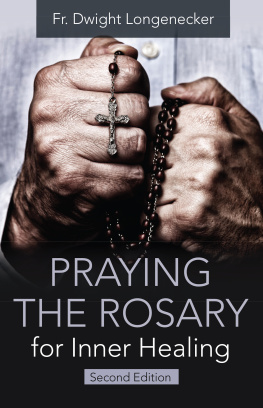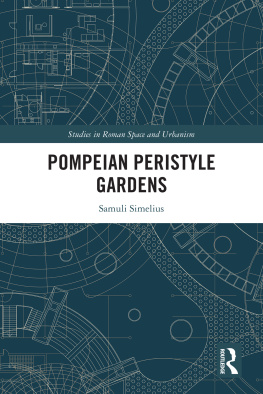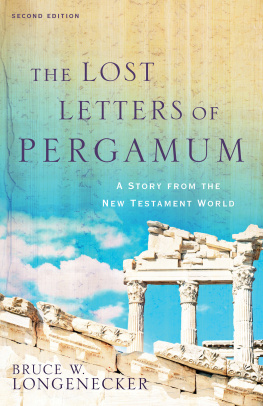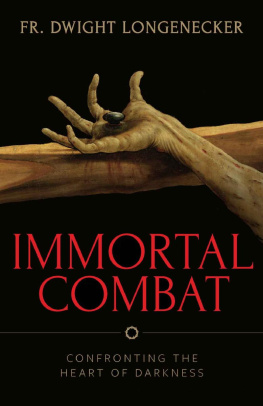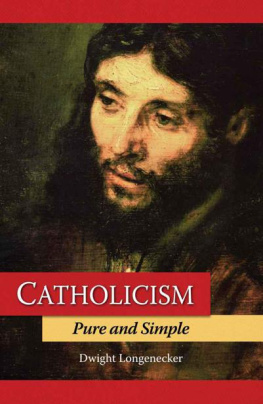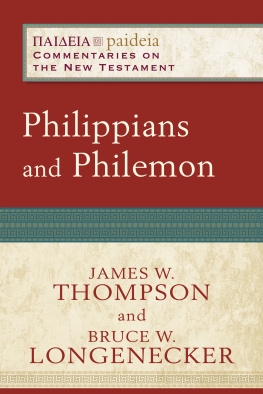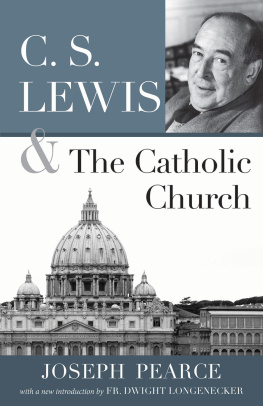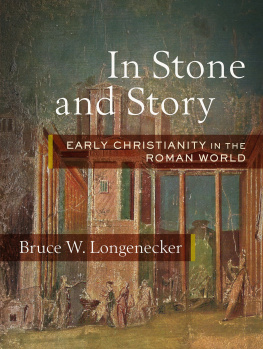Bruce Longenecker - Early Christianity in Pompeian Light
Here you can read online Bruce Longenecker - Early Christianity in Pompeian Light full text of the book (entire story) in english for free. Download pdf and epub, get meaning, cover and reviews about this ebook. year: 2016, publisher: Fortress Press, genre: Religion. Description of the work, (preface) as well as reviews are available. Best literature library LitArk.com created for fans of good reading and offers a wide selection of genres:
Romance novel
Science fiction
Adventure
Detective
Science
History
Home and family
Prose
Art
Politics
Computer
Non-fiction
Religion
Business
Children
Humor
Choose a favorite category and find really read worthwhile books. Enjoy immersion in the world of imagination, feel the emotions of the characters or learn something new for yourself, make an fascinating discovery.
- Book:Early Christianity in Pompeian Light
- Author:
- Publisher:Fortress Press
- Genre:
- Year:2016
- Rating:4 / 5
- Favourites:Add to favourites
- Your mark:
- 80
- 1
- 2
- 3
- 4
- 5
Early Christianity in Pompeian Light: summary, description and annotation
We offer to read an annotation, description, summary or preface (depends on what the author of the book "Early Christianity in Pompeian Light" wrote himself). If you haven't found the necessary information about the book — write in the comments, we will try to find it.
Early Christianity in Pompeian Light — read online for free the complete book (whole text) full work
Below is the text of the book, divided by pages. System saving the place of the last page read, allows you to conveniently read the book "Early Christianity in Pompeian Light" online for free, without having to search again every time where you left off. Put a bookmark, and you can go to the page where you finished reading at any time.
Font size:
Interval:
Bookmark:
EARLY CHRISTIANITY IN POMPEIAN LIGHT
People, Texts, Situations
Copyright 2016 Fortress Press. All rights reserved. Except for brief quotations in critical articles or reviews, no part of this book may be reproduced in any manner without prior written permission from the publisher. Visit http://www.augsburgfortress.org/copyrights/ or write to Permissions, Augsburg Fortress, Box 1209, Minneapolis, MN 55440.
Cover image: Photo: Osiek Figure/Daily Life/Bruce W. Longenecker
Cover design: Laurie Ingram
Library of Congress Cataloging-in-Publication Data
Print ISBN: 978-1-4514-9010-7
eBook ISBN: 978-1-5064-1897-1
The paper used in this publication meets the minimum requirements of American National Standard for Information Sciences Permanence of Paper for Printed Library Materials, ANSI Z329.48-1984.
Manufactured in the U.S.A.
This book was produced using Pressbooks.com.
For Andrew Wallace-Hadrill
Also from Fortress Press
Bruce W. Longenecker,
The Crosses of Pompeii: Jesus-Devotion in a Vesuvian Town (2016)
The Cross before Constantine: The Early Life of a Christian Symbol (2015)
Peter Oakes,
Reading Romans in Pompeii: Pauls Letter at Ground Level (2013)
Some lines are drawn to separate and divide. Other lines are drawn to connect and conjoin. This book is more about connections than about separations. It explores a fruitful point of interface between academic disciplines that are often divided by lines of separation. That point of interface is the Greco-Roman town of Pompeii, whose potential for interdisciplinary inquiry remains largely untapped with regard to the study of Christianity in its earliest urban settings. The essays within this book seek to tap into some of that potential.
In the mid-first century, a movement started along a trajectory of religious devotion that would eventually lead to the establishment of a major world religion. The inchoate Jesus-movement proclaimed a deity who had been crucified and resurrected. Meanwhile, in the year 79 ce , the mountain known as Vesuvius erupted violently some two hundred miles south of Rome. Its ash covered Pompeii, and the slow process of reclaiming the town from its ash-bound captivity began, in earnest, only within the last two hundred years.
Being what they are, the structures of higher education have virtually predetermined that the early Jesus-movement is to be studied under the umbrella of religion (for instance, in departments of theology and religion), while the material remains of Pompeii are studied under the umbrella of the classical world (for instance, in departments of history, art, and classics).
The division of labor is not necessarily contrived, but it does contain a degree of artificiality. This is because the uncovered world of Pompeii allows us to peer back in time, capturing a heightened sense of what life was like on the ground in the first century the very time when the early Jesus-movement was beginning to find its feet. Urban centers were primary contexts for the generation and expansion of Jesus-groups throughout the Mediterranean basin, and Pompeii (together with Herculaneum down the road) provides some of the most promising archaeological resources for reconstructing what life was like in those first-century centers. Greco-Roman literary texts reveal much about their world, but the urban centers entombed by Vesuviuss eruption add further clarity and depth. It is as if a two-dimensional picture gives way to a three-dimensional one when the material remains of the Vesuvian urban centers are brought into the frame of reference provided by literary sources. This is because those Vesuvian urban centers illuminate the life of the common man and woman of the Greco-Roman world more than any other archaeological site of that bygone time.
Historians of the early Jesus-movement are awakening to the potential of Pompeiis treasures for casting light on the settings and situations that were commonplace and conventional for the first urban Christians. Asking fresh questions in light of the Vesuvian material remains, scholars are beginning to perceive new contours, nuances, and subtleties within early Christian texts and the situations those texts address and promote. Enhanced interpretative sensitivities of this kind have been expanding and developing with time, and there is no reason to think that the end is anywhere in sight. With further novelty and intrigue lying ahead, it is an exciting time to explore the interface between the Vesuvian contexts and the early Jesus-movement.
The six chapters of this book comprise contributions from some who have pioneered the way for the incorporation of Pompeian material realia into the study of early Christianity (Carolyn Osiek and David Balch), from others who are following closely along similar paths (Peter Oakes and Bruce Longenecker), and from others who represent the next generation of fresh voices (Natalie Webb and Jeremiah Bailey).
The majority of these essays (except for those by Webb and Bailey) were presented at a symposium on November 6, 2015, sponsored by financial initiatives from the Institute for Studies of Religion and the Department of Religion, both housed within Baylor University. The interaction between scholars and others in attendance was engaging, enriched no doubt by the presence of Andrew Wallace-Hadrill, an internationally renown expert on Pompeii and Herculaneum, who had been invited to offer reflections on the symposium presentations and on the general interface of Pompeii and early Christianity. Professor Wallace-Hadrills robust interaction has helped to improve the essays in this book, and each symposium member has articulated indebtedness to him for his contributions. After the symposium, the symposium presenters participated in another level of engagement, writing peer reviews of each others essays and adjusting their own submissions in light of those reviews.
Each of the six essays in this book explores different dimensions of Pompeiis potential to refine our lenses for interpreting the texts and situatedness of early Christianity. Apart from a keen historical curiosity, the essays share no common template of inquiry. The issues raised by some of the essayists place Pompeian realia front and center; the issues raised by other essayists require those realia to be interwoven with other strands of evidence from the Greco-Roman world. But regardless of their foci and approach, each essay makes use of Pompeian evidence to accentuate aspects of the Greco-Roman world, thereby giving added impetus to particular approaches or angles of vision in the investigation of early Christianity.
It is hoped that these essays might be some of the first fruits in a larger academic harvest. They are offered in the hope of stimulating further harvests beyond the covers of this book. The time is ripe for giving full consideration to the realia of the Vesuvian towns in order to enhance our understanding of early Christianity in its Greco-Roman context. Perhaps the study of the Greco-Roman world will be similarly enriched in the process.
- My thanks go to Thomas Kidd and Leone Moore for their organizational oversight of the symposium, and to Beverly Gaventa, Mikeal Parsons, and Todd Still for chairing the symposiums sessions. Edward Adams also offered a helpful paper at the symposium, but unfortunately his contribution is not included here, since personal issues prevented his project from coming to full completion prior to the publication deadline for this book.
Font size:
Interval:
Bookmark:
Similar books «Early Christianity in Pompeian Light»
Look at similar books to Early Christianity in Pompeian Light. We have selected literature similar in name and meaning in the hope of providing readers with more options to find new, interesting, not yet read works.
Discussion, reviews of the book Early Christianity in Pompeian Light and just readers' own opinions. Leave your comments, write what you think about the work, its meaning or the main characters. Specify what exactly you liked and what you didn't like, and why you think so.


